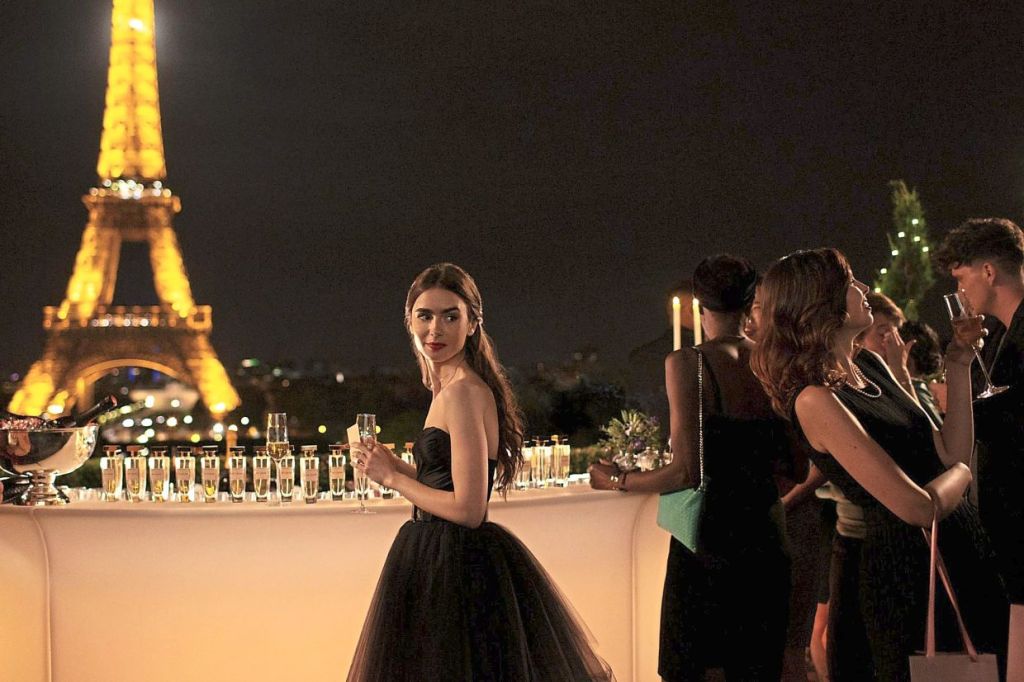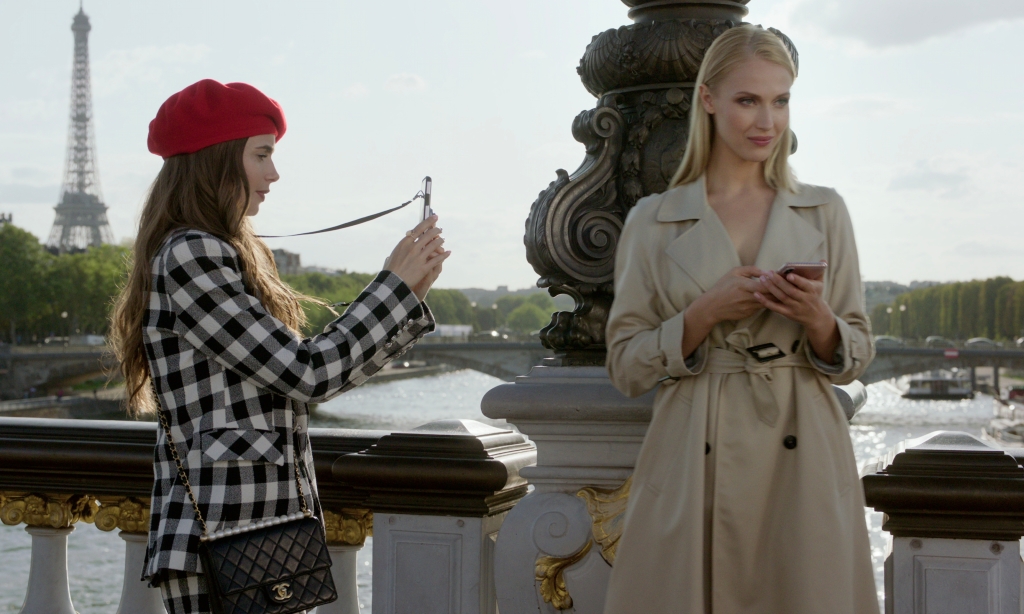This post contains minor spoilers for the Netflix series Emily in Paris – tune out now if you haven’t already inhaled the show in one sitting and don’t want to know how long it takes Emily to get to Paris etc.

Emily in Paris doesn’t beat around the bush when it comes to getting its protagonist to said city. Much like a porno film of old, it begins with an extremely brief and tenuous set up including some interactions with a generic boyfriend character (who is quickly cut). Literally only four minutes of exposition later, Emily is rolling down the Champs-Élysées.
It must be said, straight up, that I would best describe this show as utter garbage. After I swiftly watched the whole series, my partner (who deftly avoided it despite being in the same locked-down house) asked me about the narrative arc of the season. The best I could muster was, “Emily succeeded in her job and slept with the guy she has a crush on”. Emily wears some truly terrible outfits, most people hate her, but a lot of men are attracted to her. She never stops working. Paris is beautiful. Not a lot happens.

Some of my favourite cringeworthy lines from the show include:
- [commenting on a perfume] “It smells like poetry”
- [after meeting a brand CEO] “I actually have a Masters in Marketing”
- [after meeting a semiotics professor] “Semiotics? The study of symbols. I have a Master of Communication” [*shrugs*]
- [on the idea of mistresses] “I’m not somebody that can share a crepe. I want the whole crepe”
- [on eating an actual crepe] “It’s funny how every culture has its pancake”
Emily is nominally in Paris to work at a marketing firm and provide “the American point of view”. That is indeed what we get from Emily. She is represented as the hard-working, relentlessly optimistic, severely earnest, unapologetically garish American. But most fascinating (to me), is that Emily is depicted as a strait-laced millennial feminist clashing with her lewd, openly sexual and decidedly “not feminist” French counterparts.
Distancing herself from her sexually liberal postfeminist mom, Sex and the City (SATC), Emily in Paris‘ rebellion entails: a) being au fait with feminism; and b) keeping a lid on sex (or at least keeping the covers pulled up). The creator of Emily in Paris Darren Star was also behind SATC, so there is much we can learn about the mediation of changing mainstream feminist ideas in comparing the two shows.
During the 2000s SATC became the key text for feminist critique of “postfeminism” – a term used to refer to the representation of women as capitalising on feminist gains of the past while simultaneously disavowing feminism. For example, as feminist scholar Angela McRobbie remarked of shows like SATC in 2008: “These new young women are confident enough to declare their anxieties about possible failure in regard to finding a husband, they avoid any aggressive or overtly traditional men, and they brazenly enjoy their sexuality, without fear of the sexual double standard”
But while SATC was all about fucking and not mentioning the shadow of feminism, Emily in Paris is all about being a career woman who seems concerned about feminism but is extremely prudish about sex. Emily is a millennial who has come of age in a world where every white woman completed a Masters in Communication and Marketing after watching Mad Men and then became a feminist after Trump beat Hillary.

There is, however, little substance to raising the spectre of feminism rather than disavowing it. As we see in Episode 3 “Sexy or Sexist” Emily’s views on the objectification of women are only relevant insofar as they have an impact on the brand she’s working for. In this episode we see Emily watching a perfume ad being filmed. It features a naked woman strolling across a bridge being admired/ogled by men, wearing “only perfume”. Emily appears shocked after watching the ad. When asked by the brand CEO what she thinks, she suggests that the ad might be sexist, depicting the naked woman as at the mercy of the male gaze. Importantly her French boss Sylvie (set up as a wickedly unfriendly character) not only tells Emily to lighten up, she says that even though she is a woman she herself is not a feminist. Here Sylvie acts as the outdated postfeminist Other to Emily’s American feminist inclinations. When the CEO asks why the male gaze is a problem, Emily responds:
“I’m worried it won’t translate in the States. In today’s climate it could come off as politically incorrect… we just need to be sensitive to the way women are thinking now. I wanna protect your brand!”
Emily suggests sharing the ad on social media and asking women to answer the question “sexy or sexist?” to “get a conversation going and…make it part of your campaign”. In other words, taking a political position is redundant. People might think the ad is sexy or sexist, but all that matters is that they end up buying the product. The show is pulling the same move. What do feminists think about sex now? *Shrugs*
Emily represents what I have termed elsewhere “entrepreneurial feminist femininity“. This is a specifically gendered mode that means identifying with feminism, adhering to and reinforcing a rigid gender binary, and most importantly focusing on achieving individual success within the given system of gender relations rather than challenging the system. This is similar to what others have termed “lean-in feminism” or “neoliberal feminism“.

Emily is distinctly entrepreneurial in spirit. All failures are opportunities for Emily. Nothing can get her down. As Silvio Lorusso argues in his excellent book “Entreprecariat“, precarious employment mixed with entrepreneurial ideology is now the dominant mode of contemporary work, where there is no work-life balance because life is work (and we love it!). Emily in Paris embodies this on every level, with endless references to her American mode of overwork, where no boundaries exist between Emily’s personal life, her influencer life on social media, or her career as a marketing expert. Emily’s feminism is only relevant insofar as it can help her more effectively sell things.
While the show is all about Emily The Career Woman, the sexually explicit aspects of SATC era take a back seat. Despite men seemingly throwing themselves at Emily, the most risqué the show gets is Emily accidentally sleeping with a seventeen year old who gives her a hickey. It’s not even close to the explicitness of Samantha’s endless sex-marathons, Charlotte’s husband-wanking issues, Carrie’s golden-shower dilemma, or Miranda’s boyfriend fingering dramas of SATC days past. And unlike her “heteroflexible” foremothers, don’t even mention the possibility of girl-on-girl action to Emily. Emily insists – over and over – that is something that would never even cross her mind (she “likes to please men”).
My guess is that with future seasons of Emily in Paris (and yes I suspect there will be many many more) part of the grand-er arc will be that Emily becomes more enculturated into the “French ways” meaning slightly less gaudy style and in turn more (under the covers) sex. We’ll get to see just how American feminism today at once distances itself from its “postfeminist” predecessors while making similar – yet decidedly less adventurous – moves.
Of course, I’ll keep watching.














